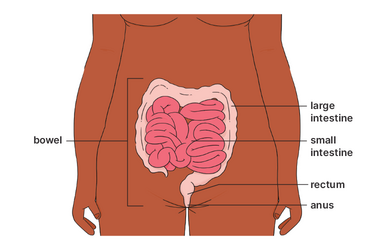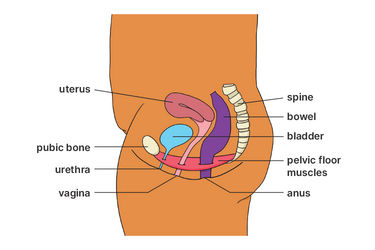Learn about what the bowel is, how it works, and what's normal when it comes to the bowel.
The bowel
The pelvic floor
What’s normal?
What’s not normal?
Good bowel health
How the gut works
Bowel cancer screening

The bowel is made up of two main parts:
The bowel is part of your digestive system. Your digestive system turns everything you eat and drink into nutrients to fuel your body.
The digestive system is a long, muscular tube that starts at your mouth and ends at your anus. It includes the mouth, oesophagus, stomach, small intestine and large intestine. The large intestine includes the rectum and anus.
Depending on what you’ve eaten, it can take 12 to 48 hours for food to travel through your digestive system.
The rectum (the last part of the large intestine) stores poo and signals you need to go to the toilet.
The anus (the end of the large intestine) has anal sphincters that keep your large intestine closed until you are ready to poo. They are supported by the pelvic floor muscles to help control your bowel.
Your pelvic floor is made up of muscles and tissues that stretch from your tailbone to pubic bone. It acts like a supportive hammock for your bowel, bladder and uterus. It’s important to keep your pelvic floor muscles strong.
Learn more about the pelvic floor and pelvic floor exercises.

It’s normal to poo from one to three times a day to once every three days.
Your poo should be soft, shaped like a sausage, and easy to pass. It should take you a minute or two to empty your bowel. If it takes longer, you may be constipated or have a bowel-emptying problem.
The colour of your poo is almost always brown due to bile, a fluid produced by your liver to help digestion. Sometimes what you eat, for example, beetroot or liquorice, can affect the colour of your poo.
It’s also normal for your poo to smell.
Bowel habits vary from person to person, but there are some symptoms you should discuss with your doctor. For example, if you have:
You should also see your doctor if you have:
Good bowel health is more than being regular (doing a poo every day). Signs of a healthy bowel include:
Learn more about bowel health on the Continence Health Australia website.
There are many things you can do to have good bowel health.
It’s important to eat a healthy diet including foods that are high in fibre such as whole grains, fruits and vegetables.
Have regular meals. Try not to skip meals, as eating helps to move food through your digestive tract.
Drink fluids regularly throughout the day, preferably water.
Stay active to help move food through your digestive tract.
It can also help to do pelvic floor exercise. Watch this Continence Health Australia video about pelvic floor muscle exercises.
Don’t ignore the urge to do a poo.
Relax when sitting on the toilet and give yourself enough time so you don't rush or strain.
Use the right sitting position on the toilet (i.e. sit with a straight back and lean forward with your elbows on your knees).
Avoid straining or holding your breath when doing a poo.
It’s important to be aware of your bowel pattern so you notice when something changes. And see your doctor if you have any concerns.
Read the Looking After Your Bowel Guide on the Continence Health Australia website.
Your gut is your gastrointestinal system, which includes your stomach, small intestine and large intestine.
Your gut contains different types of bacteria (also known as the ‘gut microbiome’). Your genetics and diet influence your gut microbiome. The more species of bacteria you have in your gut, the healthier your gut is. A healthy gut may contain more than 1,000 species of bacteria .
Poor gut health is linked to many health problems, including obesity, diabetes, heart disease, anxiety, skin conditions and inflammation associated with autoimmune conditions.
You can improve your gut health by:
Learn more about good food for gut health and how to nourish your gut bacteria.
Bowel cancer is when cancerous tissue grows inside the lining of the large intestine. Bowel cancer is the third most common type of newly diagnosed cancer in Australia.
About 47% of people diagnosed are women. The risk increases with age, but if found early, more than 90% of cases can be successfully treated.
Unfortunately, most bowel cancers show no symptoms in the early stages, so many people don’t know something is wrong until it’s too late. The most common symptom of bowel cancer is blood or mucus in your poo.
Regular bowel cancer screening can reduce the risk of illness or death from bowel cancer by detecting tiny amounts of blood in your poo.
Learn more about bowel cancer screening.
Learn more about bowel cancer causes, symptoms and treatments. Visit the Cancer Australia website.

This content has been reviewed by a group of medical subject matter experts, in accordance with Jean Hailes policy. It has been produced in partnership with the Continence Foundation of Australia.
© Jean Hailes Foundation. All rights reserved.